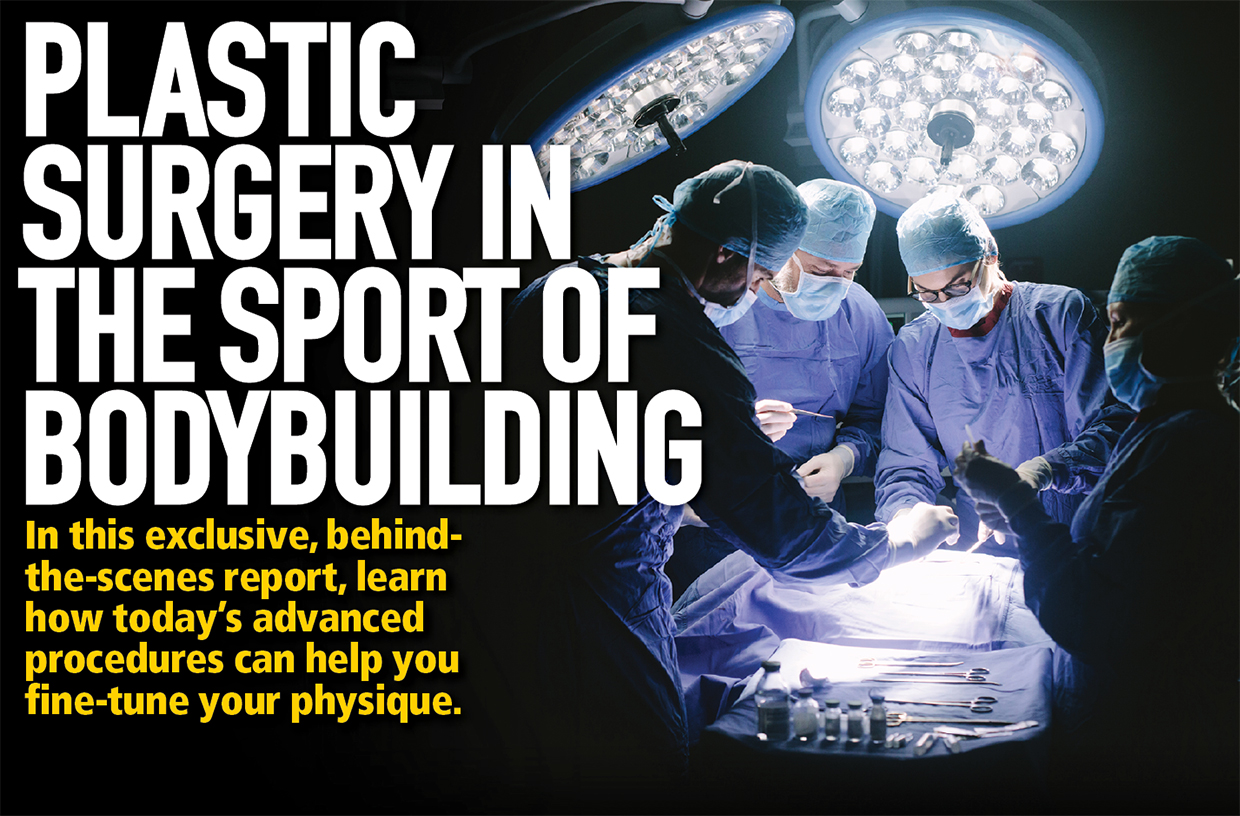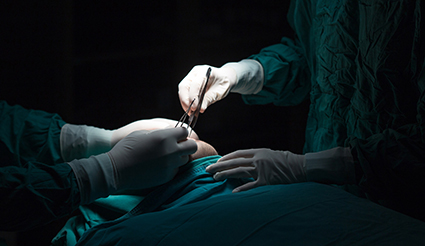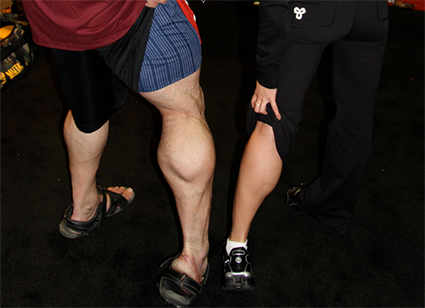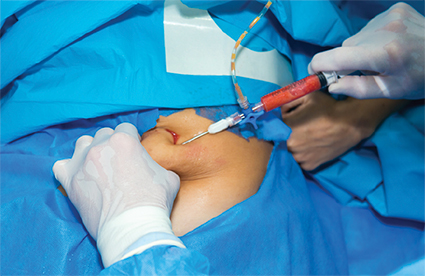Plastic Surgery In Bodybuilding

In this exclusive, behind-the-scenes report, learn how today’s advanced procedures can help you fine-tune your physique.
It was the 1990s, a decade in bodybuilding marked by the rise of mass monster– like competitors, lucrative contracts, online communities, and underground forums. Meanwhile, big-name supplement companies emerged to provide a host of muscle builders and fat burners for anyone desperate for an extra edge. In theory, the person wanting to build a mountainous chest or sculpt a chiseled six-pack had all the support he needed. But another virtually unexplored avenue for physical greatness existed: plastic surgery. Calf implants, pec implants, and glute implants all became viable options for bodybuilders and fi tness enthusiasts who had previously struggled with these areas. Even abs—one of the most difficult body parts to perfect—could be fine-tuned with the help of something called “ab etching.”

What Exactly Is Gynecomastia?
Gynecomastia is a condition in which boys or men develop lumps under their nipples, causing them to stick out and resulting in abnormally large or feminine breasts (often called “bitch tits”). Gynecomastia is extremely common and can be embarrassing for those who have it. Of all the procedures Dr. Silverman performs for his male patients, gynecomastia treatment is the most popular. “It’s very hard to put a number on the amount of top bodybuilders who’ve had their gynecomastia done, but it’s pretty common,” he explains. “You only really hear about it if there’s a horror story. Generally speaking, gynecomastia is much more common with steroid use.” In order to provide the best treatment, Dr. Silverman seeks full disclosure from patients, even if it means admitting to drug or prohormone use. “My patients are pretty honest about using if they do,” he says. “Every now and again, I’ll get someone who’s a little evasive, but I’ll explain that the issue is that he has a risk for reoccurrence. We want to make sure we treat the gynecomastia right and aren’t neglecting something. So when I meet with patients for consultation, I make it clear that I need to know if there are any factors that would contribute to their condition.”

Dr. Rick Silverman, a world-renowned cosmetic and reconstructive plastic surgeon based in Massachusetts, first started getting requests for this new procedure in the mid ‘90s. “When people started asking me about ab etching, I’d say, ‘Well, I don’t really do it,’” he recalls. “But I started getting more and more requests for it. The first people that came in for ab etching were male strippers. Their complaint was that they’d have to get so lean to get their abs to come out that their faces would get sunken in and they wouldn’t look as handsome. As dancers, they didn’t have to be ripped with striated glutes, but they still wanted a six-pack for women who were sticking money in their G-strings. If you do liposuction in the abdominal region—or ab etching—you don’t have to diet down quite as much.”
Today, people from as far away as Japan, England, and Germany travel to Massachusetts just to see Dr. Silverman. What sets his practice apart is his client base: About 60 to 70 percent of his patients are dedicated fitness enthusiasts or bodybuilders.
“I went to medical school for pediatrics, but in my third year, I discovered I didn’t want to be a pediatrician after all,” says Dr. Silverman. “I had done a rotation in plastic surgery and really enjoyed it. Then I got into a plastic surgery program in Worcester, Massachusetts. I went to a gym there, and the guy behind the desk started sending me gynecomastia patients. At the same time, Jay Cutler, who’s from Worcester, became a friend of mine. He encouraged me from early on to start competing myself. So through doing a contest and having these patients, this niche created itself. It was an accident more than anything!”

Fine-Tuning vs. a Fast Fix
With the words “cosmetic surgery” come plenty of preconceived notions—one of them being that it can magically turn a couch potato into a champion bodybuilder. “Many people assume that cosmetic surgery is the easy way out, but it’s not,” Dr. Silverman says. “You won’t be contest ready just because you’ve had it. You still have to do the work. It’s just that the surgery may help you get a little further than you might have on your own.”
At the highest levels of competition, where conditioning is key and judging is fierce, Dr. Silverman sees liposuction as a great option for someone who’s exhausted all other means of dieting and training and still has stubborn problem areas.
“Lower back is an area I’ve performed liposuction on in some men to get that detail,” he says. “If that’s the area that you hang onto till the very end, treating it with liposuction might allow you to go in five pounds heavier and have that area be nice and sharp. But if someone comes to me and says, ‘I’m here for liposuction. What can you do for me?’ and he has 30 percent body fat, I just tell him it’s like taking sand from the beach. I can’t do anything for him. I’ll give him the name of a trainer, and I’ll go over diet. And I’ll say, ‘When you get down to such and such a point, come back and we’ll talk about it again.’”
 Dr. Silverman takes the same approach with ab etching. His patients must fall into the 10–12 percent body fat range—or have 14 percent body fat, tops—before he’ll do the procedure. “All I do is a little focused suction in the areas where the deeper cuts are, just to enhance them a little more,” he says. “Patients still have to diet, especially if they want to be super-ripped. But this allows them to have a little better abdominal definition even if their body fat is a bit higher. It’s a way to fine-tune.”
Dr. Silverman takes the same approach with ab etching. His patients must fall into the 10–12 percent body fat range—or have 14 percent body fat, tops—before he’ll do the procedure. “All I do is a little focused suction in the areas where the deeper cuts are, just to enhance them a little more,” he says. “Patients still have to diet, especially if they want to be super-ripped. But this allows them to have a little better abdominal definition even if their body fat is a bit higher. It’s a way to fine-tune.”
To the untrained eye, cosmetic surgery may or may not be noticeable. “For something like calf implants, you get a scar right behind the knee,” says Dr. Silverman. “It’s usually pretty well-hidden in the crease, and it fades over time. I suppose if someone was able to see a bad scar there, it could be a giveaway. Pec implants go in through incisions in the armpits, and it’s the same sort of scenario. The implant is under the muscle, so the muscle is moving over top of it. With a calf implant, the implant is over the muscle, so it might seem a little smoother or rounder. You wouldn’t get the sort of double-diamond thing that people talk about, with the really nice, well-defined calf.”
Very few of Dr. Silverman’s patients are top-level bodybuilders, however. Most of his clients compete at the regional level or simply fall into the “wannabe” category. “The guys I’ve done pec implants and calf implants on are usually just people who can’t get those body parts to respond, or who have really defi cient chests or calves compared to other muscle groups,” he says.
Throughout his career, Dr. Silverman has heard his share of crazy requests. His receptionist often gets calls from people asking if his office does penile enlargements—which it doesn’t. “I’ve advised my secretary to just tell those callers that the doctor says, ‘If you rub it, it works every time,’” he jokes. “I know she’s said it at least once.”
Meanwhile, with a massive chest on just about every bodybuilder’s wish list, Dr. Silverman isn’t surprised by all the requests he gets for crazy pec implants. “I hear from guys looking for ridiculously big chests,” he says. “But to do that, you’d have to, in theory, put in two
implants and stack them. That’s something that’s discouraged in the United States.”

With less stringent standards outside the U.S., it’s no wonder that “surgical tourism” has become more popular, with people travelling internationally to seek cheaper surgery. “They’re going to places like Central America, South America, or Asia to have procedures done,” Dr. Silverman explains. “I think if you speak the language fluently, if you have family in those areas, or if you’re from there, then more power to you for saving your money. But if you’re a white-bread American from Rhode Island and you’re taking your first trip abroad to Thailand to have plastic surgery … I don’t know that I would do that!”
So how much will it cost you for treatment in America? That depends on where you live and what you’re looking for. At Dr. Silverman’s clinic, non-invasive procedures such as Botox are on the lower end of the price spectrum. “You might be surprised by how many people are getting Botox,” he says. “I do a fair bit for both men and women who come in from the gym. Generally speaking, people who want to look good want to look good everywhere.” Prices get steeper with body-contouring procedures involving multiple areas (such as treating sagging skin after significant weight loss). Basically, the more areas you treat, the higher your bill will be.

Still, it’s not just the wealthy who are lining up to see Dr. Silverman. “One of the most common myths is that cosmetic surgery is something that only rich people have done,” he says. “Obviously wealthy people have procedures, but they aren’t so expensive that everyday people can’t afford them too. My practice is different since I cater mostly to fi tness enthusiasts and bodybuilders. But typically, it’s middle-class women who get the most procedures done.”
Cosmetic Surgery A Head-to-Toe Price List*
| Botox | $450 - $650 | Based on the number of areas treated |
| Gynecomastia Treatment | $6,000 | |
| Pec Implants | $7,200 - $8,200 | Based onthe use of silicone gel |
| Calf Implants | $7,200 - $8,200 | Based on the use of saline or silicone gel |
| Liposuction | $4,500-$10,000 | Based on the number of areas treated |
*Prices vary and are determined on a case-by-case basis.

A Practice Rooted in Bodybuilding
After competing in multiple shows and continuing to live the bodybuilding lifestyle himself, Dr. Silverman can relate to his patients on a whole other level. “A lot of people in medicine lose sight of the value of exercise and good diet,” he says. “Anyone can say, ‘You need to eat better and you need to exercise,’ but if you look at them and they’re 40 pounds overweight and look 10 years older than they really are, it can’t be encouraging. So my goal has always been to serve as a role model for my patients. I’ve had people come to me from quite a distance just because of my bodybuilding experience. I get patients who are looking for a procedure— but who also want guidance after the procedure. I’m able to help offer that.”
Where are you in your bodybuilding journey? Have you maxed out your training and eaten chicken breasts till you’re blue in the face, but still haven’t gotten the results you want? Then learn more about Dr. Rick Silverman and his practice by visiting: RickSilverman.com.
Click HERE to sign up for our free newsletter!

